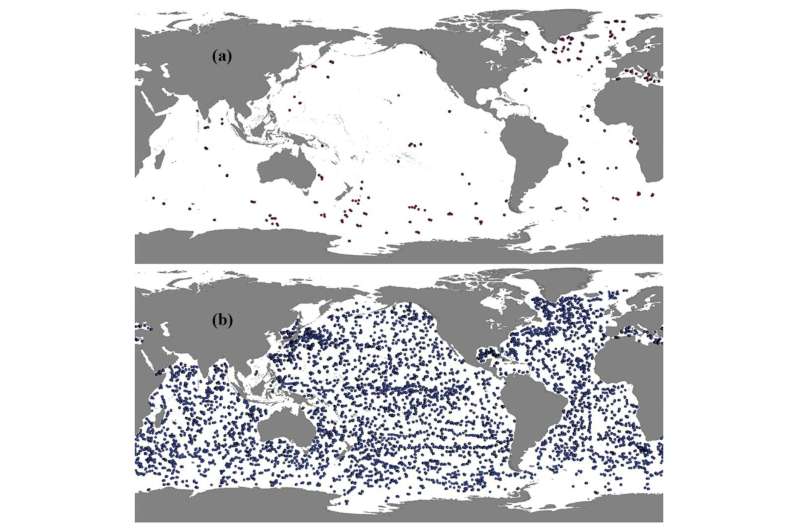This article has been reviewed according to Science X's editorial process and policies. Editors have highlighted the following attributes while ensuring the content's credibility:
fact-checked
trusted source
proofread
Scientists develop novel model and dataset for ocean dissolved oxygen monitoring

Chinese scientists have recently developed a novel method for measuring dissolved oxygen (DO) levels in the ocean and a new dataset for monitoring dissolved oxygen concentration (DOC) of global oceans.
DO is a key indicator of seawater quality. Its depletion, known as ocean deoxygenation, poses a significant threat to marine ecosystems and the carbon cycle.
Argo data refers to oceanographic measurements collected by autonomous floats worldwide. It provides crucial information on ocean temperature, salinity, and other key variables for scientific research and climate monitoring.
Historically, data on ocean dissolved oxygen from Biogeochemical-Argo had been scarce and unevenly distributed. Satellite estimates had been confined to surface waters.
The new model effectively enhanced the value of DO data by offering monthly data on DO levels spanning from 2005 to 2022 and covering 26 standardized depths. This detailed data unveiled how DO is distributed in the deep sea and highlighted a rapid expansion of deoxygenated areas.
The model can accurately predict DO levels in the middle to upper ocean using surface data, showing that it works well.
This approach offers detailed insights into oxygen variations across diverse locations and time, enabling researchers to detect and understand the changes in the oxygen levels of oceans.
Furthermore, researchers created a comprehensive global dataset of ocean dissolved oxygen concentration over time and space. Adopting data from Argo floats collected between 2005 and 2022, this dataset offered detailed information on how DOC is distributed throughout the world's oceans.
The research results have been published in Remote Sensing, Geoscience Data Journal, and Marine Environmental Research.
Traditional datasets are often limited in spatial and temporal coverage. In this study, the new dataset solved this problem by incorporating information from more than 2.35 million temperature and salinity profiles collected by Core-Argo floats, as well as more than 380,000 profiles of DOC gathered by Biogeochemical-Argo floats.
By using advanced machine learning methods, this data integration specifically demonstrated how DO levels vary across the globe and change over time.
Meanwhile, the newly established dataset matches well with existing datasets such as WOA18 and GLODAPv2, especially at depths of 10 and 1000 meters below sea level.
This new data resource is anticipated to be useful for several purposes, including monitoring the spread of low-oxygen ocean zones and supporting the "Global Ocean Oxygen Decade" initiative, which aims to improve the monitoring and prediction of changes in ocean oxygen levels.
"With this new model and dataset, scientists are now better equipped to monitor and forecast changes, enabling the development of more effective strategies for safeguarding marine ecosystems," said Prof. Xue Cunjin, who led the study at the Aerospace Information Research Institute of the Chinese Academy of Sciences.
More information: Zhenguo Wang et al, A Reconstructing Model Based on Time–Space–Depth Partitioning for Global Ocean Dissolved Oxygen Concentration, Remote Sensing (2024). DOI: 10.3390/rs16020228
Cunjin Xue et al, A global four‐dimensional gridded dataset of ocean dissolved oxygen concentration retrieval from Argo profiles, Geoscience Data Journal (2024). DOI: 10.1002/gdj3.251
Bo Ping et al, Retrieval of subsurface dissolved oxygen from surface oceanic parameters based on machine learning, Marine Environmental Research (2024). DOI: 10.1016/j.marenvres.2024.106578
Provided by Chinese Academy of Sciences


















